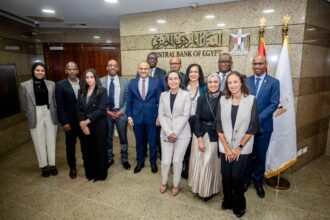The ratio of non-performing loans (NPLs) at banks operating in the Egyptian market fell to 4.9% of their total loan portfolios at the end of December 2017, versus 5.3% in September 2017, according to the Central Bank of Egypt (CBE).
In a recent report on the financial soundness of banks, the CBE stated that the NPLs ratio amounted to 3.4% of the total loans in the top 10 banks operating in the Egyptian market, while the ratio reached 2.9% among the top five banks.
According to the CBE, the banks made allocations for 98.7% of the total NPLs in December 2017. The ratio of these provisions amounted to 100% in the top 10 banks operating in the Egyptian market.
The report also noted that the total volume of provisions amounted to EGP 109.979bn at the end of December 2017 and the top 10 banks in Egypt had a share of EGP 68.175bn of these provisions, while the top five banks alone accounted for EGP 57.742bn.
Moreover, the CBE stated that the banks set up reserves of EGP 180.244bn at the end of December 2017, with the share of the top 10 banks amounting to EGP 139.022bn, and the volume of reserves at the top five banks reached EGP 115.995bn.
In addition, the CBE noted that the loan-to-deposit ratio (LTD) at banks operating in the Egyptian market fell to 44.2% in December 2017 compared to 45% in September 2017, and fell to 41.6% among the top 10 banks and 42.6% among the top five.
LTD in local currency fell to 36.6% in December 2017 from 37% in September 2017. It also fell to 32.2% at the top 10 banks and 32.6% at the top five.
The ratio of loans to foreign currency deposits at banks fell to 68.4% in December from 69.8% in September. The same indicator reached 72.4% at the top 10 banks and 80.5% at the top five.
The CBE explained that the private sector accounted for 63.2% of the total loans granted by banks until the end of December 2017 compared to 63.7% at the end of September.
The private sector also accounted for 55.6% of loans granted by Egypt’s top 10 banks and 52.5% of loans granted by the top five.
“The total deposits at banks up to the end of December 2017 amounted to about EGP 3.314tn, of which the top 10 banks account for about EGP 2.451tn, while the top five banks account for EGP 2.07tn,” the report read.
The CBE added that the deposit asset ratio (DAR) in December 2017 increased to 69.2% from 67.7% in September 2017. The ratio stood at 67.3% for the top 10 banks and 66% for the top five.
The average bank local liquidity ratio in December 2017 grew to 44.9% from 41.7% in September 2017 and the same stood at 46.6% at the top 10 banks and 44.7% at the top five.
The average foreign currency liquidity ratio at all banks fell to 73.5% at the end of December 2017, compared to 74.8% in September 2017. The ratio rose to 75.9% at the top 10 banks and 67.5% at the top five.
On a related note, the CBE said that bank securities portfolios reached 14.2% of total bank assets in December 2017, unchanged from September 2017. This ratio was 15.3% for the top 10 banks and 14.7% for the top five.
It also pointed out that banks’ investments in securities and treasury bills amounted to EGP 1.7tn by the end of December 2017. The investments of the top 10 banks in securities and bills amounted to about EGP 1.351tn, and about EGP 1.142tn among the top five.
“The total capital of banks operating in the Egyptian market amounted to EGP 140.901bn by the end of December 2017,” according to the CBE.
The CBE added that the capital of the top 10 banks amounts to about EGP 91.213bn, while that of the top five banks scored EGP 73.036bn.
While the CBE refrained from naming the top five and 10 banks in Egypt, it is known that they include the National Bank of Egypt, Banque Misr, the Commercial International Bank (CIB), the Arab African International Bank, QNB Alahli, HSBC, Faisal Islamic Bank, the Bank of Alexandria, and Crédit Agricole.
Regarding the capital adequacy index, the CBE explained that the capital-to-risk weighted assets ratio (CRAR) at banks rose to 15.2% by the end of December 2017 compared to 14.7% in September 2017. This ratio was 14.9% among the top 10 banks and 15.1% at the top five.
The ratio of the tier 1 CRAR rose to 12.1% in December 2017 compared to 11.9% in September 2017. The ratio was 11.5% for the top 10 banks and 11.5% for the top five of these.
According to the CBE, the ratio of banks’ common equity to risk-weighted assets stood at 8.8% in December 2017, compared with 8.5% in September 2017. The ratio was 7.9% for the top 10 banks and 7.7% for the top five banks.
Banks’ leverage ratio also fell to 6% in December from 6.3% in September. The ratio stood at 5.6% at the top 10 banks and 5.4% at the top five.
The CBE said that the percentage was recommendatory starting from the end of September 2015 until 2017 and obligatory from 2018 at a minimum of 3%.




